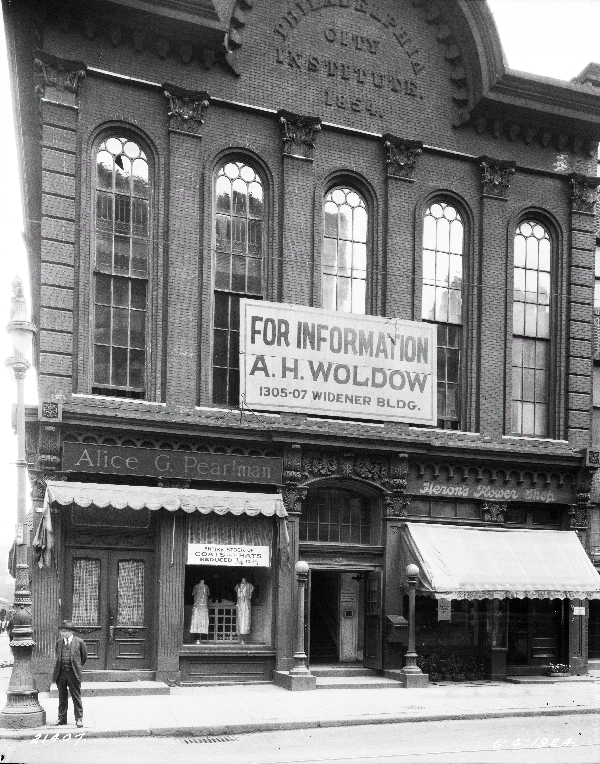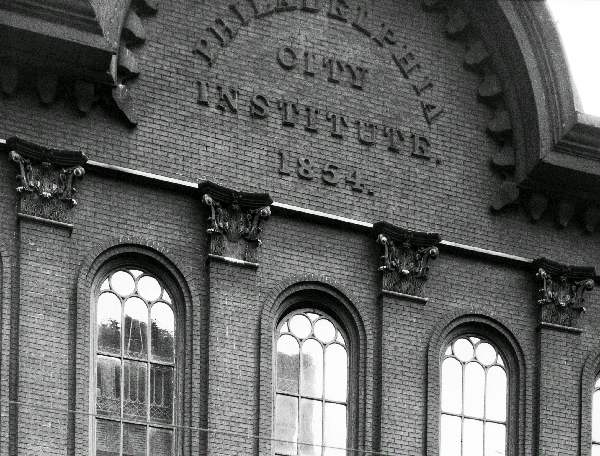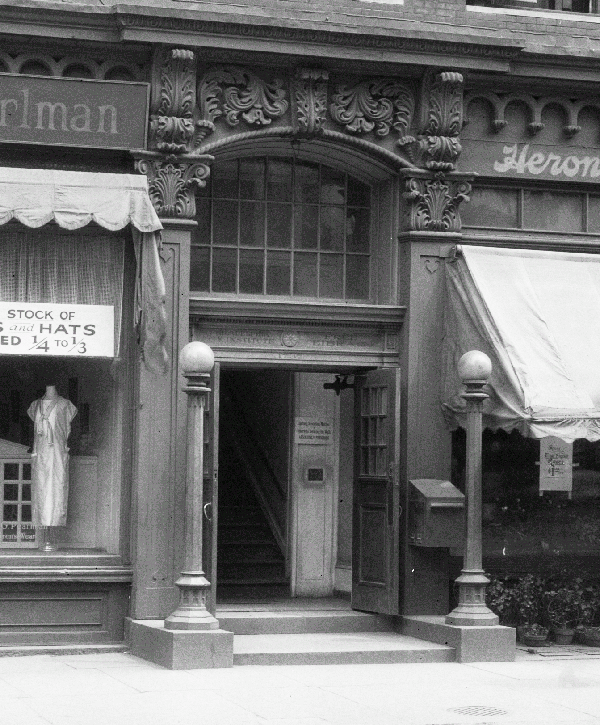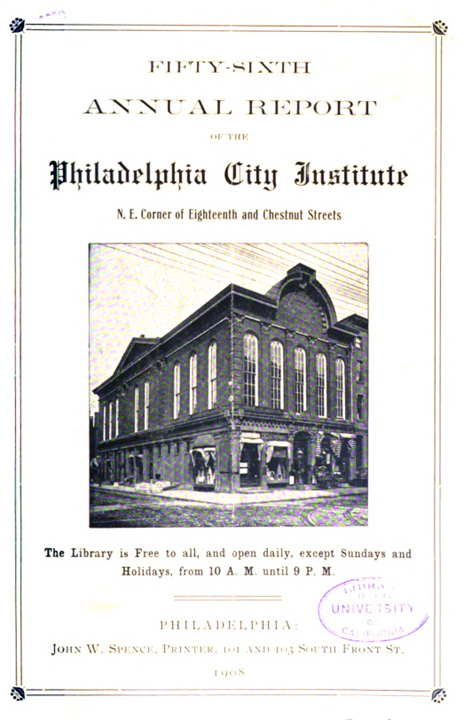Something had to give.
Philadelphia’s outbursts of street violence in the 1830s grew even more familiar in the following decades. “By any measure,” writes historian Michael Feldberg, “the period from 1835 to 1850s was the most violent in Philadelphia history.”

A group of well-intentioned, philanthropic citizens donated $34,000 for what they called the Young Man’s Institute. The idea was to stem the tide of violence by providing appealing, accessible and constructive alternatives.
The thinking, according to contemporary reports: Philadelphia was home to “a large class of young persons, who, from the poverty or neglect of parents, or having none to care for them, have very little opportunity” for formal education. “Common labor or the workshop claims all their time. They grow up in the vigor of youth and manhood with little moral or social restraint.”
And so, “their evenings are given to the streets.” They “frequent the ever open groggeries, drinking saloons, beer shops and other places” and are “tempted to occupy their leisure moments in worse than idleness…” They “descend step by step until they are irretrievably ruined.” What might be done “to rescue from the streets and from the downward career of vice, profanity, and ruin, many of these idle and vagrant boys?” Leaders of the Young Man’s Institute considered the Apprentices Library as a potential model. Since 1820, this institution promoted “orderly and virtuous habits” as well as “the desire for knowledge” to “advance the prosperity and happiness of the community.” But with only one location at 5th and Arch Streets, the Apprentices Library had limited impact. The Young Man’s Institute would build branches where needed, in several of the city’s most vulnerable and volatile sections. Collectively, they would strive to transform the city’s youth and improve “public peace and the safety of the community.”

In time, branch locations would include the Moyamensing Literary Institute at 11th and Catherine, the Mechanics’ Institute of Southwark at Fifth street below Washington Avenue, the West Philadelphia Institute at 39th Street above Market Street, the Kensington Literary Institute at Front Street and Girard Avenue and the Spring Garden Institute at Broad and Spring Garden Streets. Branch locations also included the Philadelphia City Institute at 18th and Chestnut Streets, which served the western side of Center City. Together, these facilities would “provide an opportunity of developing the crushed genius and honorable ambition of the young men of poverty and toil.”
At 18th and Chestnut, the Philadelphia City Institute’s corner-stone was set in place on May 22, 1854 and the building opened the following March. On the second story was a “splendid Lecture Room, 75 by 44 feet, and a Reading Room, 40 by 38 feet.” The Board of Managers had the highest of hopes imagining that “future Franklins, Rittenhouses, Fultons, and Awkrights [sic] may date their fortunes and their fame on the day they first entered our library.”
From the start, free access was universal. “Every man over 14 years of age is admitted. . . without charge, on a certificate of good character and inability to pay.” The reading room opened every evening at 6pm, and remained open until 10pm, every day except Sunday, all year round.
Books were arranged in categories: history, biography, arts, mechanics, voyages and travels, and literature, augmented by “a well-selected Library for reference and circulation.” Books were “in open cases unobstructed by wire netting or wooden fences” as in other libraries. Readers had “free access to the books and the valuable privilege of selecting books which they desire to examine.”
At first, the Philadelphia City Institute offered 832 books and attracted an average of twelve readers per day. Rapid growth ensued and in the final years of the 19th century, the library had more than 15,000 books and accommodated an average of more than 360 readers per day.

In addition to the library and from the start, the Philadelphia City Institute offered “a course of Lectures on useful knowledge and general literature” as well as classes in other categories. Weekly lectures and a free night school launched the first year with popular topics featuring “Evils of Our Times” presented by Philadelphia’s Mayor, Richard Vaux. Other lectures included “Young America,” “Tendencies of Modern Science,” “Culture of the Beautiful,” “William Penn and the Holy Experiment,” and “Education, Intelligence, and Morality, the Pillars of Freedom.” To take stock of the entire project, lectures included “the City Institute and Its Results.”
But, according to the annual reports, lectures “failed to draw audiences of the class of persons intended to be reached—young workingmen.” For a time, music was added on Saturday evenings. and while these concerts attracted “immense crowds of boys of all ages” many were “roughs’ of the streets” and “became troublesome” to both the Institute and its neighborhood.
About the same time, the Managers considered the possibility of adding a “Smoking Room” with games as a possible popular attraction. But upon further consideration they concluded the “excessive abuse of tobacco already prevalent with the young” and concluded it was neither “expedient or proper to add any inducement of that kind in the Institute.”
What did work, starting in the early 1870s, was a “night school for females whose education had been neglected.” This 17-week curriculum “opened … with marked success.” More than 100 attended.
The Institute continued at 18th and Chestnut until 1923, at which point the building was sold and the collection moved to West Rittenhouse Square. In the mid-1940s it joined with the Free Library of Philadelphia. And in 1956, the Philadelphia City Institute moved again, this time to 1905 Locust Street, where remains to this day.
“We claim to be the freest library in the world,” rightly bragged the Philadelphia City Institute in its vintage annual reports, “a fountain of intellectual refreshment, never stagnant, never stinted.”
[Sources: Michael Feldberg, “Urbanization as a Cause of Violence: Philadelphia as a Test Case,” in The Peoples of Philadelphia, (Temple University Press, 1973); John Richard Uberti. Men, Manners and Machines: The Young Man’s Institute in Antebellum Philadelphia, (University of Pennsylvania dissertation, 1977); Philadelphia City Institute Records 1852-1999. The Historical Society of Pennsylvania Collection #3023 PDF.
An Appeal in Behalf of the Philadelphia City Institute, For Improvement of Young Men. (Philadelphia: inquirer Book Press), 1855; First Annual Report of the Managers of the Philadelphia City Institute. (Philadelphia: Printed by G.T. Stockdale, 1856); Nineteenth Annual Report of the Managers of the Philadelphia City Institute (Philadelphia: G.T. Stockdale, printer, 1871); Twenty-second Annual Report of the Managers of the Philadelphia City Institute (Philadelphia: Mack & Braden, Book and Job Printers, 1874); Forty- First Annual Report of the Managers of the Philadelphia City Institute, (Philadelphia: John Spence, Printer, 1893);
“Philadelphia City Institute-To the Public,” The Philadelphia Inquirer, June 20, 1853; “Girls’ Night School,” The Public Ledger, October 30 1872; “Origin of Some Local Libraries.” The Philadelphia Inquirer, April 23, 1893; “The Philadelphia City Institute,” The Philadelphia Inquirer, April 16, 1894.


3 replies on “Antidote to Urban Violence?”
Thanks as always Ken for another fascinating snippet of how we got here!
For more info on that era of violence I recommend the Found In Philadelphia podcast. Episode 14, Violence in the Streets offers good insight. https://foundinphiladelphia.com/episodes/
Thanks! Good podcast.